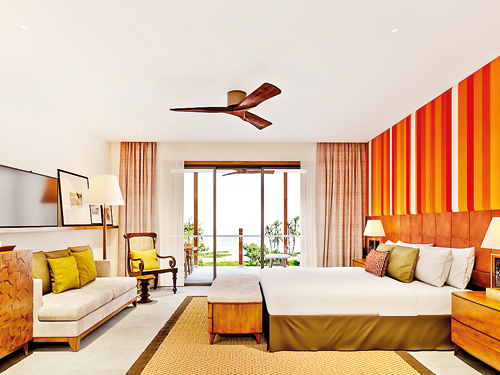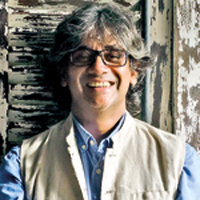A nod to the past, also the present

Unique site and building: A place where guests would never forget where they are
On Friday last week, just as the architect Channa Daswatte sat down for an interview with the Sunday Times, a ceiling was sliding into place at the Bentota Beach Hotel. Ena de Silva’s stunning batik design had been a key element in the building Geoffrey Bawa worked on between 1967 and 1969, and its restoration to a place of pride has been one of the final steps in an extraordinary project that literally saw this iconic building dismantled and rebuilt, nearly from the ground up.
Five or six years ago, this building was decrepit, says Channa, the architect hired to effect this ambitious transformation. However, not only was the building itself something of a national treasure, the site it occupies is particularly stunning: sandwiched between two beaches in Bentota, it offers easy access to the Bentota River on one side, and a view of the highlands and Adam’s Peak from the highest level of the building. It is a tourist’s dream.
When it came time to work on the hotel, Channa’s conversation with John Keells revolved around how to best restore it to its full glory. It was clear to all that a superficial sprucing up would not be enough – the problem was with the bones of the building, where the concrete had begun to feel the wear of years. They saw the possibilities thanks to another project ongoing at the time: the Ena de Silva house was being moved from its location in Colombo and rebuilt with painstaking attention to detail at Lunuganga, Bawa’s garden estate in Bentota.

Luxurious shades: The newest five-star on the beach
“We managed to convince the board at John Keells that the Bentota Beach Hotel should be similarly conserved as a valuable piece of modern architecture,” Channa says, “That it could be dismantled and rebuilt on the spot.”In this process they would attempt to be faithful to Bawa’s original design, skipping the additional wing that had been added in later years as well as the changes implemented in subsequent renovations.
This was somewhat easier said than done, as few records existed of the time. The team knew Bawa had relied on a variety of natural materials which had been locally sourced, as imports were heavily restricted during the 1960s. So he had used elements that were beautifully, recognizably Sri Lankan: terracotta tiles and dark wood columns and balustrades as well as polished concrete floors, which Bawa believed would age gracefully. Now as the team set to work, they wanted to identify which of these could be preserved.
To manage this, the architect turned to a collaborator from the Ena de Silva project – conservation expert Nilan Cooray, who with his characteristic attention to detail set about carefully salvaging, numbering and archiving whatever elements of the structure which could be saved. “The project placed conservation at its core,” says Channa
For the interiors, Channa turned to the archives of the Geoffrey Bawa Trust for original plans and sketches, and tapped Bawa’s old friends like the team at Barefoot to identify key elements of the interiors, such as the fabric that had once adorned the ceiling of the café. They found some of the original furniture on the premises and were able to commission reproductions. A detail that Channa is particularly pleased with is the restoration of a series of drawings of fantasy creatures by Ismeth Raheem that were once hung in the lounge. When approached, Ismeth was delighted to rely on his own photographs to recreate the artwork for the hotel.
Channa knows what they have on their hands is not an identical replica, but that is not his intention – he hopes instead to simply recreate the sensibility of that bygone era, nodding gently to Sri Lanka in the 60s.

Channa Daswatte. Pic by Dhanushka Amarasekera
However, the building also diverges in significant ways from the original, Channa having been commissioned to reimagine it for a modern era in which the hotel itself has expanded from offering just 30 rooms to 120. With more guests to cater to, the restaurant and café areas Bawa had initially planned weren’t spacious enough. In addition to a generous new dining and recreation areas, the management wanted to create three blocks of larger rooms, add staff quarters as well as a dedicated children’s area. There is also to be a section that will serve as a kind of small museum and exhibition space, and which will initially feature drawings and artefacts that shed light on the history of the Bentota Beach Hotel, but which Channa hopes will expand over time to also showcase the work of artists Bawa so enjoyed working with.
“Geoffrey would use artists to enhance the experience of the building, rather than merely decorate it,” says Channa, citing for instance Laki’s (Senanayake) flamboyant peacock that stands at the head of the main staircase, and now also marks the main entrance to the new section. The Ena batik is another example. “If it wasn’t there, you would look up and see an ordinary pink or white ceiling,” says Channa. “Instead you look up at this extraordinary piece of art. The building would not have been the same without it.”
Channa took a cue from his mentor, when he decided art would once again be a vital part of the Bentota Beach Hotel which now features modern artists working in a range of disciplines from visual artists like Sameera Kalupahana and Bandu Manamperi; painters like Sanjeewa Kumara and Sujith Rathnayake; fashion designers like Himanshi Wijeweera; the textile designer Marie Gnanaraj and the batik artists Sonali Dharmawardena and Nilanka Perera. There is also the ceramicist Ajith Perera; the sculptor Kingsley Gunatillake and the photographer Dominic Sansoni.
Among these, eight artists were selected to give the 16 suites an identity based on their own artwork, and in larger spaces like the ballroom you will see the work of contemporary Sri Lankan batik artists. Channa is very well pleased with the results and hopes that the building will be a showcase for how artists and architects can collaborate closely.
Meanwhile, the Bentota Beach Hotel will continue to stand as a tribute to Bawa’s vision for how Sri Lankan, and indeed South Asian architects could create spaces that celebrated the best of their own country’s architectural traditions and crafts and respond in considered ways to their own unique terrain and climate. Before this hotel, Channa says those venturing into building for tourism often thoughtlessly replicated the sterile concrete boxes produced in Europe. But Bawa wanted something that reflected its context, a building where the guests never forgot where in the world they were.
“Not every piece of architecture can be a monument. Not every building is going to change how architects think and practise,” says Channa, explaining that this project became for him a kind of palimpsest to work on. It was a building that had inspired his approach to architecture, and redefined how people thought of building for tourists, and for the architect the question was now how to “confer with memory”, to build on what existed seamlessly so that the hotel offered the facilities, luxuries and spaces we take for granted today.
For Jit Gunaratne, President Leisure, John Keells Group, the opening, today (Sunday 15th), comes at a notable juncture. “This is an important year for Cinnamon Hotels & Resorts with three hotel openings within a few months of each other. We are especially looking forward to the re-opening of Cinnamon Bentota Beach, especially as the very first five-star property to open in Sri Lanka following the incidents of April 2019. This hotel will be an iconic building that infuses heritage with luxury to offer travellers an inspiring destination experience,” he told the Sunday Times.
Meanwhile, Channa is looking forward to seeing guests encounter the property for the first time. “We wanted to ensure that guests would not miss the point of the original building but be able to go through it and take from it experiences that they could carry away with them,” says Channa. “Really, it has been about creating an experience.”


